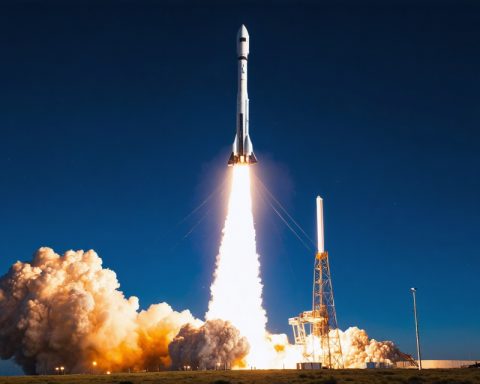- Rocket Lab’s Electron rocket successfully launched a BlackSky satellite, enhancing satellite imagery with its Gen-3 capabilities that offer 35-centimeter resolution and improved data transfer through intersatellite links.
- This advancement promises significant improvements in global surveillance and intelligence services.
- SpaceX launched a Falcon 9 rocket carrying 23 Starlink satellites, marking a historic first landing on a droneship near The Bahamas.
- This event represents a new chapter, expanding possibilities for future missions, including those aimed at polar orbits.
- The synchronized launches of Rocket Lab and SpaceX underline a surge in space exploration, highlighting the industry’s growth and ambition.
Amidst the twilight glow of New Zealand’s horizon, the Rocket Lab Electron rocket ascended, heralding a new era in satellite imagery. The new BlackSky satellite, now orbiting earth from a height of 470 kilometers, promises revolutionary insights. Designed with enhanced Gen-3 imaging capabilities, it pierces through smoke and haze, offering an unprecedented glimpse at a resolution of 35 centimeters. Notably, these satellites come equipped with advanced intersatellite links, enabling rapid data transfer with a worldwide reach. BlackSky’s innovation marks a significant stride in global surveillance, enhancing services for defense and intelligence networks.
Almost simultaneously, across the globe, SpaceX was scripting its own chapter in aerospace history. Their Falcon 9 rocket soared from Cape Canaveral, with 23 Starlink satellites hitching a ride to orbit. Yet, the spectacle did not end at launch. In a bold maneuver, the Falcon 9 booster touched down on a waiting droneship nestled among the cerulean waters of The Bahamas. Not only was this a first for SpaceX, but it was also a pioneering moment for The Bahamas, linking its destiny with space exploration. This strategic landing broadens the compass for future flights, including ventures towards polar orbits.
These synchronized celestial launches highlight a crescendo in space exploration, underscoring a symphony where the sky isn’t the limit, but merely the launch pad. For both Rocket Lab and SpaceX, the ambition transcends terrestrial confines, opening new portals in our understanding of what lies beyond. As they forge paths above, the message remains clear: the universe beckons, and these pioneers are ready to answer its call.
Unlocking the Sky: The Future of Satellite Technology and Space Exploration
Introduction
In recent developments, Rocket Lab and SpaceX have made significant strides in space exploration, with Rocket Lab launching the BlackSky satellite and SpaceX successfully deploying 23 Starlink satellites. The implications of these technological advances are vast, offering new capabilities in satellite imagery, data transfer, and space travel.
How-To Steps & Life Hacks: Leveraging Satellite Technology
For industries relying on satellite technology, understanding how to utilize these advancements is crucial. Here are strategies to maximize the benefits:
1. Integrate High-Resolution Imagery: Companies can integrate BlackSky’s Gen-3 imaging for precise environmental monitoring, urban planning, or disaster response.
2. Enhance Data Transfer: Leverage the intersatellite links for faster, more reliable communication, crucial for remote sensing applications and disaster recovery.
3. Optimize Communication Networks: Businesses can tap into the expanded Starlink constellation to improve internet connectivity in remote and underserved areas.
Real-World Use Cases
– Defense & Intelligence: Enhanced surveillance capabilities from BlackSky provide detailed insights necessary for national security.
– Telecommunications: Starlink’s expanded network facilitates high-speed internet in rural areas, promoting digital inclusivity.
– Environmental Monitoring: High-resolution imagery aids in tracking climate change impacts, such as deforestation and ice melt.
Market Forecasts & Industry Trends
The global satellite imagery market is projected to reach $5.2 billion by 2027 with a CAGR of 11.5% (source: MarketsandMarkets). The demand for high-resolution imagery and rapid data transfer is set to grow as sectors like defense and telecommunications expand their reliance on satellite data.
Reviews & Comparisons
– BlackSky vs. Other Imaging Satellites: BlackSky’s Gen-3 technology offers superior resolution compared to legacy satellites, improving image clarity under challenging environmental conditions like smoke or haze.
– SpaceX Starlink vs. Traditional ISPs: Starlink offers competitive speeds and accessibility in areas lacking traditional infrastructure, though latency can be an issue in heavily wooded or urban areas.
Controversies & Limitations
– Space Debris Concerns: The increase in satellite launches raises the risk of space debris, potentially impacting future space operations.
– Environmental Impact: While space technology advances, the carbon footprint of launches and satellite manufacturing remains a concern.
Features, Specs & Pricing
– BlackSky Gen-3 Satellites: Offering 35-centimeter resolution and advanced intersatellite communication for swift data transfer.
– SpaceX Starlink: Pricing starts at $110 per month for internet service, with equipment costs at approximately $599.
Security & Sustainability
– Enhancing cybersecurity measures is vital as data sharing increases via intersatellite links.
– Both Rocket Lab and SpaceX are investing in sustainable practices, including reusability (e.g., Falcon 9 booster landings).
Insights & Predictions
– Expect continued growth in satellite deployment, with frequent launches becoming the norm.
– As technologies mature, prices for satellite services may drop, democratizing access further.
Tutorials & Compatibility
Users looking to integrate satellite data into their own systems can start with online platforms like BlackSky’s Spectra AI, offering user-friendly access to satellite imagery (source: BlackSky).
Pros & Cons Overview
Pros:
– High-resolution imagery and rapid data transfer for critical applications.
– Quick expansion of global communication networks.
Cons:
– Potential environmental and orbital debris concerns.
– Initial high costs can deter smaller enterprises.
Actionable Recommendations
1. Businesses should explore partnerships with satellite service providers to enhance operational capabilities.
2. Governments need to establish policies to manage space debris and ensure sustainable space use.
3. Consumers could benefit from exploring Starlink as an alternative ISP where coverage is an issue.
For more on these significant players and their contributions to space exploration, visit Rocket Lab and SpaceX. Enjoy exploring the new horizons of technology and remember: the sky isn’t the limit—it’s just the beginning.







